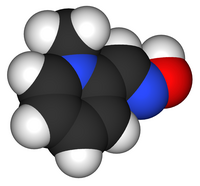Pralidoxime
 |
|
 |
|
| Clinical data | |
|---|---|
| AHFS/Drugs.com | Micromedex Detailed Consumer Information |
| Pregnancy category |
|
| ATC code | |
| Legal status | |
| Legal status |
|
| Identifiers | |
|
|
| Synonyms | 1-methylpyridine-6-carbaldehyde oxime |
| CAS Number | |
| PubChem CID | |
| IUPHAR/BPS | |
| DrugBank | |
| ChemSpider | |
| UNII | |
| KEGG | |
| ChEBI | |
| ChEMBL | |
| ECHA InfoCard | 100.027.080 |
| Chemical and physical data | |
| Formula | C7H9N2O+ |
| Molar mass | 137.159 g/mol |
| 3D model (Jmol) | |
|
|
|
|
Pralidoxime (2-pyridine aldoxime methyl chloride) or 2-PAM, usually as the chloride or methiodide salts, belongs to a family of compounds called oximes that bind to organophosphate-inactivated acetylcholinesterase. It is used to combat poisoning by organophosphates or acetylcholinesterase inhibitors (nerve agents) in conjunction with atropine and diazepam.
Pralidoxime, 2-pyridinaldoxime methylchloride, is synthesized by reacting picolinaldehyde (2-formyl pyridine) with hydroxylamine, giving pyridine-2-aldoxime, which is further reacted with methyl iodide, giving the desired pralidoxime.
Pralidoxime is typically used in cases of organophosphate poisoning. Organophosphates are a family of compounds that strongly inhibits acetylcholinesterase, an enzyme essential for proper muscle and nervous system functioning. The acetylcholinesterase enzyme has two parts to it. An acetylcholine molecule, binds at both end to both sites of the enzyme, is cleaved in two to form acetic acid and choline. In organophosphate poisoning, an organophosphate binds to just one end of the acetylcholinesterase enzyme (the esteric site), blocking its activity. Pralidoxime is able to attach to the other half (the unblocked, anionic site) of the acetylcholinesterase enzyme. It then binds to the organophosphate, the organophosphate changes conformation, and loses its binding to the acetylcholinesterase enzyme. The conjoined poison / antidote then unbinds from the site, and thus regenerates the enzyme, which is now able to function again.
After some time though, some inhibitors can develop a permanent bond with cholinesterase, known as aging, where "-doximes" such as pralidoxime cannot reverse the bond. Pralidoxime is often used with atropine (a muscarinic antagonist) to help reduce the parasympathetic effects of organophosphate poisoning. Pralidoxime is only effective in organophosphate toxicity (i.e. it does not have an effect if the acetylcholinesterase enzyme is carbamylated, as occurs with neostigmine, physostigmine, or insecticides such as carbaryl).
...
Wikipedia
